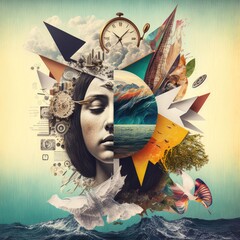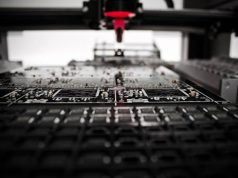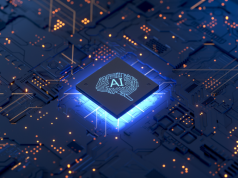By Carmen Greger
Artificial Intelligence (AI) has been making significant advancements in the field of art in recent years. AI art refers to the use of computer algorithms and artificial neural networks to create and generate art. The relatively new phenomenon of AI art has both its benefits and potential negatives, depending on who you ask. As time progresses and the future unveils itself, it is sure to become crystal clear.
Benefits of AI Art:
- Efficiency: AI art is much faster and efficient than traditional art. An AI algorithm can generate an artwork in a matter of seconds, whereas traditional art could take hours or even days to complete. This speed and efficiency make AI art a useful tool for artists and designers who need to create many artworks in a short amount of time, or as a foundation of one piece or many that can be further personalized by the human hand.
- Creativity: AI algorithms can create unique and never-before-seen artworks. These algorithms can generate new forms, styles, and compositions that might not have been possible with traditional art methods. This new form of art generates new avenues for creativity and innovation in the field of art, even for the exceptionally skilled artist wishing to add a potentially elevated approach to their design.
- Accessibility: AI art also makes it possible for people with limited artistic abilities to create art. AI algorithms can assist in the creation process, giving rise to new opportunities for those who may not have the skills or resources to create art traditionally.
- Cost-effective: Traditional art materials, such as paint and canvas, can be expensive. AI art eliminates the need for these materials, making it a cost-effective alternative for those who want to create art but do not have the financial resources to purchase traditional art supplies.
Potential Negatives of AI Art:
- Lack of Human Touch: One of the major drawbacks of AI art is that it lacks the depth and potency of human touch that is present in traditional art. AI algorithms can create stunning artworks, but they cannot alone replicate the emotional connection and personal expression that is present in traditional art, (that said, many artists simply utilize AI, not as a stand alone tool, but solely to further enhance their own personal creations via custom trained models).
- Lack of ‘Authenticity’: AI art is often seen as lacking authenticity as it is created by computer algorithms and not by human hands. This can make AI art less valuable and less desirable in the art world compared to traditional art. (That said, it is important to note that AI must take specific instruction from the artist using it as a tool, so the question then becomes does the artist’s unique expression potentially expand through technological methods?)
- Lack of Control: AI algorithms are designed to create art in a specific way, and artists may have limited control over the final product. This can result in artworks that do not initially meet the artist’s expectations or that are not in line with their personal style or vision.
- Ethics: There is a growing concern about the ethics of AI art, particularly when it comes to intellectual property rights. Who owns the rights to an artwork created by an AI algorithm – the artist, the software developer, or the algorithm itself? These questions need to be addressed to ensure that the rights of artists and software developers are protected, but it seems that the policies are evolving to inspire and guide the creative to mindfully and proactively site specific or general foundational sources as necessary.
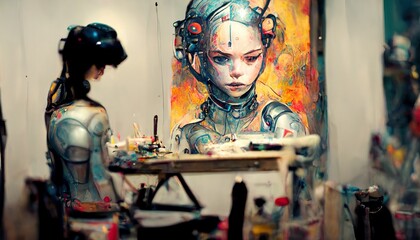
AI art has the potential to revolutionize the field of art, but it also raises important questions about authenticity, expression, ethics, and control. As AI continues to evolve, it is important that artists, designers, and policymakers consider the benefits and negatives of AI art and work together to ensure that the future of art is shaped and shared in a responsible, inspirational and ethical manner.
I had the opportunity to speak with Laura Rafferty, a seasoned and celebrated multi-dimensional, multi-passionate gifted artist who kindly offered some insight on her integrative, cutting edge and exquisite work with Artificial Intelligence:
“As an artist who’s created my entire life with a wide variety of tools like encaustic wax, oil paint, airbrush, screenprinting, glassblowing, costume design, and metal sculpture… I find it my personal mission to always be exploring the new intersections of art and technology.
Here’s a rewrite of a rebuttal post to the negativity I’ve been experiencing around my AI work:
https://twitter.com/LauraDoodlesToo/status/1616837568967868417
As the post mentions, to achieve the pieces I create, I use custom models, python coding, mixed media painting and integration, and hundreds of thousands of outputs to curate before I ever bring it into photoshop.
AI is a tool for learning and self-expression. I’ve heard arguments that AI makes artists lazy and that it can’t create anything with personal meaning, but I believe these generalizations are false and judgmental.
Again, I use custom trained models on my own artwork, python coding, mixed media painting and integration, and hundreds of thousands of outputs to curate before I ever bring it into photoshop. I’ve never pushed myself so hard technically and conceptually before.
I use AI because it’s fun, allows me to create work even when I work two jobs, and allows me to learn and grow in ways I never thought possible. Just as you can use a pencil to create a beautiful unique piece, or trace someone else’s work, a tool is just a tool. It’s the intention, message, ethics, and artist behind the work that defines creative expression”.
In a reply comment to Laura’s Twitter post addressing the negativity around AI Art, Charlie Magee writes:
“Beautiful, Laura. Maybe don’t worry too much about the ‘judgmental and hateful’ part? Happened with looms and buggies. The haters faded. They ended up wearing manufactured shirts and buying cars. Every moment paying attention to them is a lost moment for your art”.
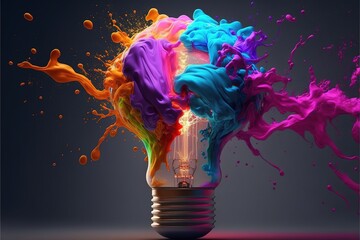
Well said, Charlie. Looks like this is a trend that will blend, not fade, and if technology can continue to be used for integrative expansion and elevation of good, without any harm to humanity, then it’s a win. Perhaps we should continue to support evolving concepts and matters of personal opinion and allow art to be both created, and in, the eye of the beholder…
Now there’s an idea.


